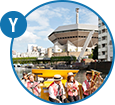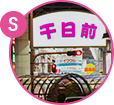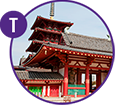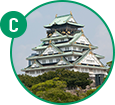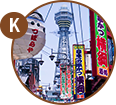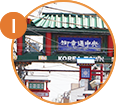
The Seven Wonders of Shitennoji Temple
2023.04.28
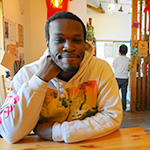

Written by: andy(andy)
● The Seven Wonders of Shitennoji Temple
Hi! I’m Andy. I’m from the U.S.A.
I’m fascinated with the wonders of Japanese temples and shrines. They are often retold as folklore, while some are urban legends or just too good to be true. “Nanafushigi” is the Japanese word to describe seven strange phenomena, similar to “seven wonders” in English. Stories about nanafushigi are passed down from generation to generation and curious people like me love them!
You might have heard of Shitennoji Temple, one of the most notable temples in Osaka. Built by a powerful politician Prince Shotoku during the Asuka Period (592 – 710 CE,) Shittenoji is known as the very first official temple of Japan. This historical temple apparently has its own seven wonders and, if you’re curious like me, you’re probably itching to know what they are.
Let’s go on an Osaka mystery tour and find out!
● East Gate to the Gokuraku-jōdo & Pon Pon Stone
Shitennoji Temple is located near Osaka Metro Tanimachi Line’s Shitennoji-mae Yuhigaoka Station. In about 5-minute walk from the station, you arrive at Nishimon Ishinotorii, the stone torii gate on the western side of the temple.

Why is there a torii at a temple? You’re right, torii gates are usually found at Shinto shrines and Shitennoji is a Buddhist temple. Various theories exist around this stone torii at Shitennoji Temple. Interestingly, this situation did not even pose a question before the Meiji Period (1868 – 1912 CE) because Shinto gods and Buddha were thought to be very close. Today, theories around this torii include claims that there is a shrine hidden inside of the temple and that it was actually not a Buddhist temple but ancient Sun Worship. Who knows what the truth is, but what we know for fact is that this stone torii is one of Japan’s Three Great Torii and is the oldest of all torii that exist today. Cool, huh?
The words in the frame hung in the center of the torii gate reads “This is the East Gate to the Gokuraku-jōdo (Buddhist paradise,) where Gautama Buddha preaches.”
This, everyone, is the first of the Seven Wonders.

If this torii is the East Gate to the Gokuraku-jōdo, that means the western side of the torii, behind where I stood is the Buddhist paradise. Wow! That means I was standing at the entrance of the paradise (lol).
The sun sets in the middle of this torii on the days of equinox (when night and day are equal length) both in spring (mid-March) and autumn (mid-September.) At the ritual of jissokan, worshippers stand facing West and quietly watch the sun go down in the center of the torii, praying for reincarnation in the gokuraku-jōdo (Buddhist paradise where no pain and only bliss exist) which is located in the far West.

The stone pillar underneath the stone torii gate is the second of the Seven Wonders, called “pon pon ishi” (literally “tap tap stone.”) When you tap inside of the square hole in the pillar, you hear a little “plop, plop.” It is said that, if you put your ear against the pillar, you can hear the voices of your ancestors in heaven.

I tried it. But I don’t think I heard the voices… (lol) Though, I did hear some sound—a sound that brings back memories, kind of like the sound of the sea in a seashell. Try it for yourself when you visit Shitennoji and maybe you’ll be more successful than me!
● Cate Gate & Dragon’s Well
As I proceeded into the temple grounds, the Great West Gate also known as Gokuraku-mon stood in front of me with the blue sky in the backdrop. It was beautiful.

And here’s the marvelous Deva Gate (Niomon) with two muscular guardian gods. So cool.

Further into the temple grounds is the Cate Gate, the No. 3 of the Seven Wonders.
It is said “the sleeping cat at the Cat Gate cries three times on the morning of the New Year’s Day.”
The current Cat Gate at Shitennoji Temple was reconstructed by the Tokugawa Shogunate in 1623 after the temple was destroyed during the winter campaign of the Siege of Osaka in 1614. The wood carving of the sleeping cat on the Cat Gate is the work of a famous sculptor, Hidari Jingorou. It is said that this sleeping cat meows with another sleeping cat—also sculpted by Hidari Jingorou but located at Nikkō Tōshō-gū Shrine in eastern Japan, couple hours North of Tokyo—on New Year’s Eve and New Year’s Day. Now that’s a long-distance friendship! Apparently, she also has the role of protecting Buddhist sutra stored in Shoryo-in’s sutra library from mice.

The tiger at the Tiger Gate nearby is also protecting the Taishi-den where Prince Shotoku himself is enshrined. The tiger looks fearless and bold. I like it.

No. 4 of the Seven Wonders is the Dragon’s Well.
The legend says this well leads to Munetsuchi, a legendary pond in India that is free of the fires that agonize people, and the protector of the pond—a dragon—lives here. I had to look into the well and…


I saw the dragon! Can you see it in the picture? The dragon painted in the ceiling is reflecting on the water below. It is said praying to this dragon can remove calamities and the evil.
● Ogre Tile of the Pagoda, North Bell Tower & Stone Coffin Cover
No. 5 of the Seven Wonders is the Onigawara (roof ridge tiles that typically depict Japanese ogre) of the five-story pagoda. On the northwest corner of the first layer of the pagoda is an onigawara tile that has the carving of three of the Seven Gods of Fortune—Daikokuten (god of wealth and prosperity) in the center, Bishamonten (god of warriors and defense against evil) on the left, and Benzaiten (goddess of arts and knowledge) on the right. It is said you can see their faces from any direction.
I looked up and found a roof ridge tile that’s different from others and covered in gold foil. It was a little difficult to see the faces, though…

Look for this special onigawara tile on the northwest corner of the Pagoda. It’s on the left side, on the first layer.

North Bell Tower is the 6th Seven Wonders. It is said the sound of the bell reaches the world beyond ours.

I like the sound of this temple bell. It’s apparently the same sound as the Oshikicho, one of the modes of Gagaku, the ancient Japanese court music and the foundation for Japanese music. It is believed the sound of this bell eases the minds of the ancestors in gokuraku-jōdo.
The last of the Seven Wonders is the Stone Coffin Cover.
Funnily, this oblong stone was originally used as a bridge within the temple grounds and it was said walking across this bridge would give an expectant mother a smooth childbirth. It was relocated when they found out it’s actually a coffin cover from Kofun Period (300 – 600 CE.) Unfortunately, though, I couldn’t find the Stone Coffin Cover when I visited. It’s under restoration right now.
● Other Highlights of Shitennoji Temple
Aren’t the Seven Wonders of Shitennoji fascinating?
The temple is full of other mysteries and so-called “power spots,” spiritual places that emanate the energy of the Earth. One such spot that piqued my interest was Gandan daishi-do hall’s Circle of Wisdom. Stepping through the Circle of Wisdom gives you good luck in academic achievement. I prayed for success in my studies of Japanese!

Other highlights of Shitennoji Temple include historical buildings and buddha sculptures.
I particularly liked the Eirei-do Hall and the buddha inside of the hall.
The writing on this pillar uses ancient scripts.

These are a memorial erected to commemorate those who died in the great earthquake and tsunami during late Edo Period in 1854.

Lots of turtles live in the turtle pond. Maybe they’re the reincarnation of turtles from elsewhere…?!
Looked like they’re enjoying themselves in the sun.

I could see how this place provides a calming space in the middle of a busy city.
Shitennoji Temple is a great spot to visit alone and enjoy the slow pace. Explore the Seven Wonders and other divine mysteries, and refresh in Osaka’s notable “power spot”!

*The information in the article is for 2021.
[Ad]
Klook.com
Spots Introduced
Grand Head Temple Shitennoji Temple
[Access] About 4 mins walk from Exit 4 at Shitennoji-mae Yuhigaoka Station.
About 9 mins walk from Exit 17 at Tennoji Station.
[Hours] April-September 8:30-16:30 (8:00-17:00 on the 21st of every month)
October-March 8:30-16:00 (8:00-16:30 on the 21st of every month except Oct.)
※ The last reception of the garden is 30 minutes ago
[Closed] Open daily (the garden has holidays)
Recommended Plans
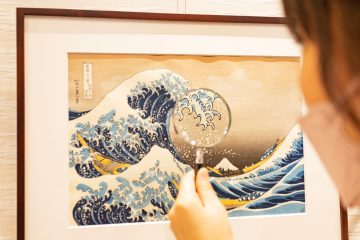
The World of Ukiyo-e:
Japonism that Captured the World
In 17th to 19th century Japan, after the turbulent and violent Warring States period ended, …
2025.06.27

An epic appearance of the Milky Way in Osaka!!
A guide to a magical night on Tanabata, July 7.
Tanabata, aka the Star Festival, is one of the traditional seasonal festivals of Japan, …
2025.06.13

A Must See Summer Festival in Osaka:
The Fantastical Tenjin Matsuri
with Mikoshi, Boats, and Fireworks
The Tenjin Matsuri (Tenjin Matsuri Festival) is one of the biggest festivals in …
2025.06.06




